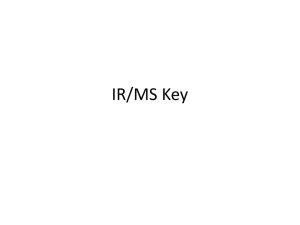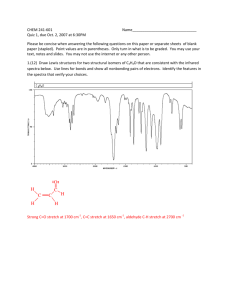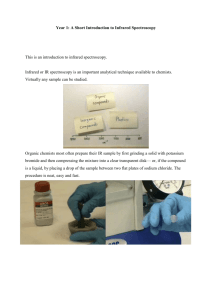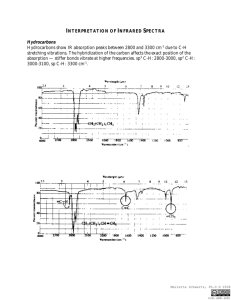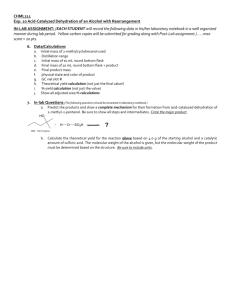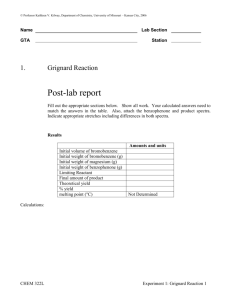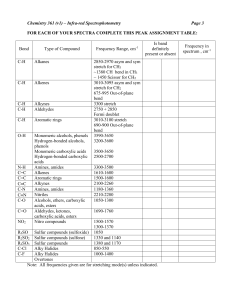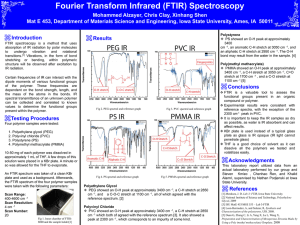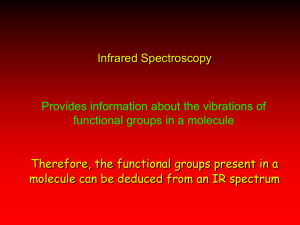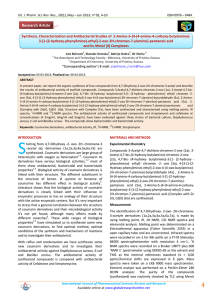Chapter 12
advertisement
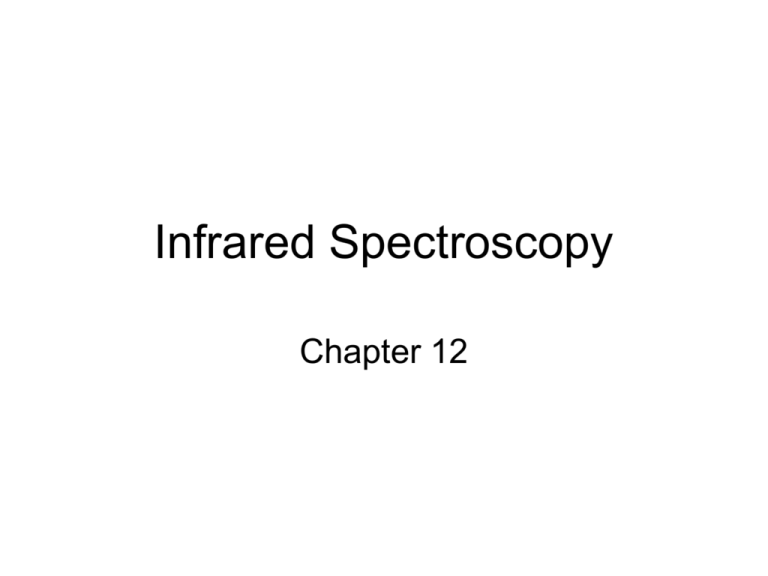
Infrared Spectroscopy Chapter 12 Energy Table 12.1, p.472 Final Exam Schedule, Thursday, May 22, 10:30 AM Fang, MD10A Kunjappu, MD10B Kunjappu, MD10C Metlitsky, MD10D 1127N Zamadar 2143N 320A Infrared spectroscopy causes molecules to vibrate A non-linear molecule having n atoms may have many different vibrations. Each atom can move in three directions: 3n. Need to subtract 3 for translational motion and 3 for rotations # vibrations = 3 n – 6 (n = number of atoms in non-linear molecule) Infrared radiation does not cause all possible vibrations to vibrate. For a vibration to be caused by infrared radiation (infrared active) requires that the vibration causes a change in the dipole moment of the molecule. (Does the moving of the atoms in the vibration causes the dipole to change. Yes: should appear in spectrum. No: should not appear.) Consider C=C bond stretch… H H F H H H F H ethylene 1,1 difluoro ethylene What about 1,2 difluoro ethylene? Different bonds have different resistances to stretching, different frequencies of vibration Table 12.4, p.478 Typical Infra-red spectrum. wavelength Frequency, measured in “reciprocal centimeters”, the number of waves in 1 cm distance. Energy. Figure 12.2, p.475 C-H C=O “fingerprint region”, complex vibrations of the entire molecule. Vibrations characteristic of individual groups. Figure 12.2, p.475 BDE of C-H 414 464 556 472 Table 12.5, p.480 BDE and CC stretch 376 727 966 Table 12.5, p.480 Alkane bands Figure 12.4, p.480 Recognition of Groups: Alkenes (cyclohexene). Compare these two C-H stretches Sometimes weak if symmetric Recognition of Groups: Alkynes (oct-1-yne) This is a terminal alkyne and we expect to see 1. Alkyne C-H 2. Alkyne triple bond stretch (asymmetric) Recognition of Groups: Arenes. (methylbenzene, toluene) Out-of-plane bend; strong Recognition of Groups: Alcohols The O-H stretch depends on whether there is hydrogen bonding present Compare –O-H vs -O-H….O Hydrogen bonding makes it easier to move the H with H bonding as it is being pulled in both directions; lower frequency Recognition of Groups: Alcohols Recognition of Groups: Ethers No O-H bond stretch present but have C-O in same area as for alcohol. C-O stretch in assymetric ethers sp3 CH3 O sp2 Recognition of Groups: Amines Easiest to recognize is N-H bond stretch: 3300 – 3500 cm-1. Same area as alcohols. Note tertiary amines, NR3, do not have hydrogen bonding. Hydrogen bonding can shift to lower frequency Esters One C=O stretch and two C-O stretches. Recognition of Groups: Carbonyl C=O stretch can be recognized reliably in area of 1630 – 1820 cm-1 •Aldehydes will also have C(O)-H stretch •Esters will also have C-O stretch •carboxylic acid will have O-H stretch •Amide will frequently have N-H stretch •Ketones have nothing extra What to check for in an IR spectrum C-H vibrations about 3000 cm-1 can detect vinyl and terminal alkyne hydrogens. O-H vibrations about 3500 cm-1 C=O vibrations about 1630 – 1820 cm-1 C-O vibrations about 1000-1250 cm-1
